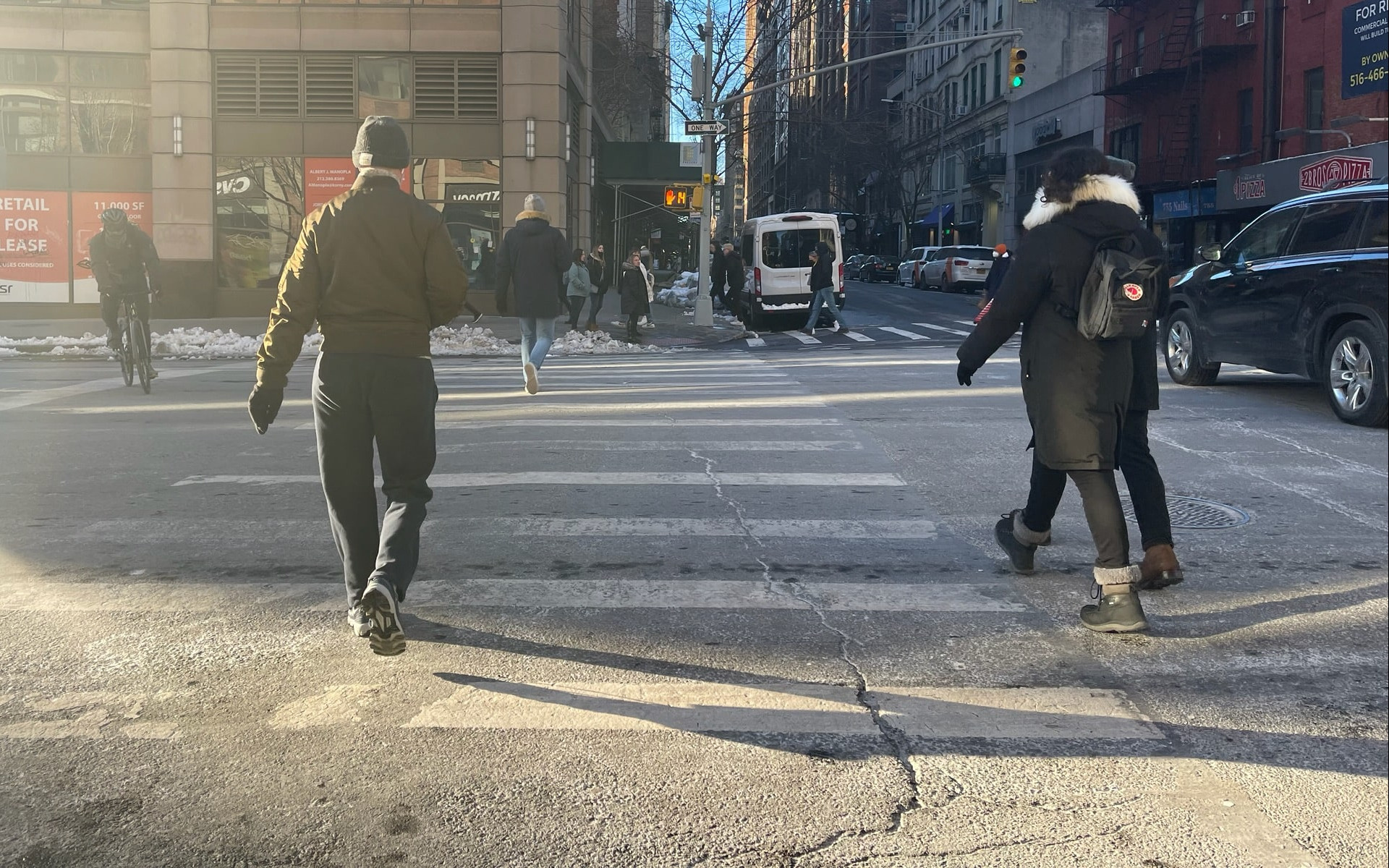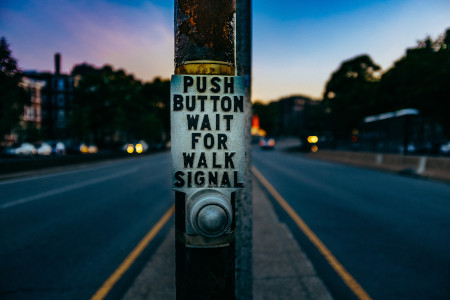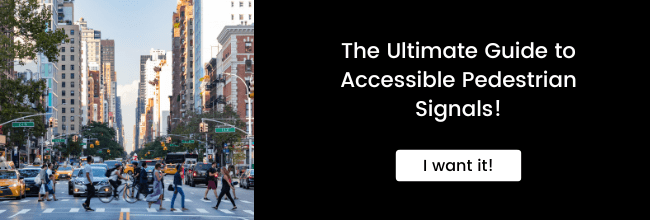
How Accessible Are the Audible Pedestrian Pushbuttons of Your Crossings?
Actuating audible pedestrian pushbuttons is the first step to crossing the street safely. They provide blind and visually impaired users audible information about the WALK and DON’T WALK signals. According to the signal, pedestrians know when it’s their turn to cross and when they need to wait.
Pushbutton-integrated accessible pedestrian signals are very common in the U.S. but how do audible pedestrian pushbuttons work exactly? What are the requirements for such a system? Does it properly meet the needs of the visually impaired? Is it really the best accessible solution for them?
Let’s unveil everything there is to know about audible pedestrian pushbuttons to make your city truly accessible and safe!
What are the benefits and disadvantages of audible pedestrian pushbuttons?
We’ve composed a list to help you comprehend what audible pedestrian pushbuttons do for blind and visually impaired pedestrians and the city itself.
| Benefits | Disadvantages |
| Presence of a locator tone to indicate the beginning of the crosswalk. | ⊗ Not all pushbuttons are equipped with one. ⊗ For those that are, this means continual noise pollution in the neighborhood. |
| Speakers integrated in the pushbutton: the sound information goes directly where users are standing. | It’s more an issue that may rise than a disadvantage but the volume of the speakers needs to be adjusted according to the ambient sound. |
| The pushbutton can be easily activated for people with mobility impairments. And its required height makes it easier for blind and visually impaired people to locate it on the pole. | In times of COVID-19, touching surfaces may contribute to the spreading of the virus. At the peak of the pandemic, many cities had to deactivate the pushbuttons of their APS. |
The pushbutton simultaneously serves 2 purposes when actuated: ⊗ It signalizes that pedestrians want to cross the street. ⊗ It provides audio information about the WALK/DON’T WALK signal for blind and visually impaired pedestrians. | There must be a high number of times when the pushbutton is activated by regular pedestrians who probably don’t need the audible information associated with it. Thus creating unnecessary noise pollution. |
As you can see, audible pedestrian pushbuttons have their pros and their cons. Does the system work? Yes, it does: it helps blind and visually impaired users cross the street.
How Do the Blind Safely Cross the Road?
But is there room for improvement regarding accessibility? Again, the answer is yes. Because you may have perceived it: one of the most challenging aspects of audible pedestrian pushbuttons is locating the crosswalk in the first place.
For people with vision disabilities, finding the beginning of the crosswalk can be difficult. Especially at intersections they’re not familiar with. How can you find the crosswalk and the pole where the pushbutton is installed when you can’t see? Yet, this step is necessary to activate the accessible pedestrian signals.
Seeing that the locator tones may not be found at all intersections, blind and visually impaired pedestrians may need extra help. Or another system.
That’s where aBeacon steps in. It’s a third generation accessible pedestrian signal which means it can be used with or without being connected to pushbuttons. As cities and all categories of pedestrians are used to push the button to actuate the APS, it doesn’t affect their everyday lives.
However, with aBeacon, users can activate it remotely with a remote control or a smartphone app. This enables them to rely on sound information to locate the beginning of the crosswalk.
Plus, the smartphone activation helps them find their bearings as they can select which crossing to activate in the destination menu. No risk of ending up on the wrong side of the avenue! After all, 89% of people with vision disabilities use a smartphone.
Such innovation can be a real asset for cities that want to be more connected. And that’s exactly what New York City has been experiencing. A Brooklyn intersection is currently testing aBeacon and the first user feedback is positive.
The aBeacon devices from both sides of the crossing are simultaneously activated to create a guiding sound corridor. It helps pedestrians with vision disabilities to cross without going off course. It works as a beacon for them.
Its high quality of sound and easy activation have been appreciated by blind and visually impaired pedestrians.
Why is aBeacon a Game Changer Regarding Accessible Pedestrian Signals?
An activation on demand dramatically reduces noise pollution for the neighborhoods as the residents living close by the equipped intersection in Brooklyn have been experiencing it. aBeacon is activated only by pedestrians who need it to cross.
For all cities, these benefits are priceless. And this makes their crossings safe, accessible and as pleasant as they can be for all users.
In addition, aBeacon can also collect data on the number of times it has been activated to let blind and visually impaired pedestrians cross the street. This can help cities better understand the needs of their visually impaired citizens when they’re getting around.
How do audible pedestrian pushbuttons work?
You already know that the point of accessible pedestrian signals is to dub the visual information related to traffic lights and their WALK / DON’T WALK signs.
They provide audio information to let pedestrians with vision disabilities know when they can safely cross the street and when they need to wait.
Locator tone
As mentioned above, locator tones don’t equip all intersections. They enable the visually impaired to know the pole location.
Their volume isn’t high but their sound is continuous. Actually, their intensity depends on the ambient sound.
According to the MUTCD, locator tones have a duration of 0.15 seconds or less, and shall repeat at 1-second intervals.
Vibrotactile arrow
Once blind and visually impaired pedestrians have reached the source of the sound emitted by the locator tone, they just need to locate the vibrotactile arrow on the pushbutton.
This tactile arrow points in the direction of travel on the crosswalk to guide pedestrians. To better serve its purpose, it needs to be installed within the width of the crosswalk or very near it and near the curb line.
It also vibrates during the WALK signal in addition to the sound information emitted by the accessible pedestrian signals. This is particularly helpful for deafblind pedestrians as they rely on their sense of touch.
Pushbutton
In the United States, many cities use pushbutton-integrated accessible pedestrian signals. This means that by pushing the button on the pole, visually impaired pedestrians actuate the APS. And other pedestrians signal their presence at the crossing.
In order to distinguish between both uses, to trigger the audible pedestrian pushbutton, blind and visually impaired people need to push the button for more than one second. If they press it a second time, they can hear the sound information again.
They have information on the signalization of the traffic lights but also on the street name they’re about to cross.
When the button is pushed, traffic lights control is aware that a pedestrian is waiting to cross the street. It allows them to have long enough time to safely get across.
Pushbuttons actually serve two different purposes.
Speakers
With audible pedestrian pushbuttons, the speakers are integrated into them so that the sound information is broadcasted directly to where the pedestrians are waiting.
To conceive accessible intersections for blind and visually impaired people, you need to know everything that composes accessible pedestrian signals, including pushbuttons.
What are the requirements for audible pedestrian pushbuttons?
Three different laws and regulations run the requirements and guidelines of audible pedestrian pushbuttons:
⊗ The Americans with Disabilities Act (ADA): this law aims at preventing any type of discrimination agains people with disabilities. Here, it requires accessible pedestrian signals to convey audio information to blind and visually impaired people. The emphasis is put on providing them with the same information as other pedestrians so that they can cross the street safely and with complete autonomy.
⊗ The Manual on Uniform Traffic Control Devices (MUTCD): manual created by the Federal Highway Administration (FHWA). It concerns the installation and use of accessible pedestrian signals and what interests here: audible pedestrian pushbuttons.
⊗ The Proposed Accessibility Guidelines for Pedestrian Facilities in the Public Right-of-Way (PROWAG): as the name indicates, they are guidelines reviewed by an independent federal agency, the Access Board. Their goal is to enforce accessibility laws and provide technical assistance about APS.
Here are the main requirements for the location of audible pedestrian pushbuttons you need to know:
⊗ Within easy reach and easily activated (including for wheelchair users),
⊗ Located at a mountain height of approximately 3.5 feet above the sidewalk (but no more than 4 feet),
⊗ Located near each end of the crosswalks,
⊗ Positioned between 1.5 and 6 feet from the edge of the curb or pavement but no further than 10 feet from the edge of the curb.
⊗ Positioned with their face parallel to the crosswalk to be used,
⊗ Obvious regarding the crosswalk they’re associated with.
Please note that if the pushbuttons on a corner can’t be separated by at least 10 feet, they can be installed on the same pole. But they both need vibrotactile arrows to each indicate the direction of travel and have a speech message for the WALK signal.
What’s essential in this situation is to avoid any sort of confusion for blind and visually impaired pedestrians. They need to know which audible pedestrian pushbutton to actuate in order to reach their destination.
But again, this may still be confusing for those who aren’t familiar with this type of intersection. That’s the reason why this situation is an exception and not the standard. It’s best to avoid it if possible as pedestrians may encounter difficulties on how to apprehend the intersection.
They may feel like they’re not safe. If it happens to be the case, a lot of vulnerable pedestrians tend to find a different route in order to avoid a difficult and stressful intersection. How would you feel if you had to walk longer just to be safe?
You now have a glimpse into audible pedestrian pushbuttons, their use and their requirements to be accessible for blind and visually impaired pedestrians. As you can see, pushbuttons work since they activate APS but locating them and the poles they’re on remain one of the most challenging issues for users with vision disabilities.
You need to ask yourself how accessible pushbuttons are and what can you do to improve this system. It may be the perfect time to try an innovation like New York City has done.
Want to know more about pedestrian safety? Check out these articles:
Everything You Need to Know About Accessible Pedestrian Signals Regulation in New York City
Pedestrian Safety: Are Your Crossings Safe for Visually Impaired and Blind People?
Removing Traffic Lights vs Pedestrian Safety: a Guide to Inclusive Streets
Published on May 6th, 2022
media

For people with vision disabilities, finding the beginning of the crosswalk can be difficult. Especially at intersections they’re not familiar with. How can you find the crosswalk and the pole where the pushbutton is installed when you can’t see?
writer

Carole Martinez
Content Manager
stay updated
Get the latest news about accessibility and the Smart City.
other articles for you

Open Data Is Key to Fostering Universal Accessibility
Open data represents an opportunity for cities to reach universal accessibility. It shows the missing links of the mobility chain.
Our Audio Beacons Guide the Blind and Visually Impaired at the Helsinki Subway
The Helsinky subway improved their audio signage system by installing on demand and remotely activated audio beacons.
7 Good Reasons to Install Audio Beacons at Your Public Transport Network
Audio beacons are an efficient way to provide more autonomy to blind and visually impaired people. They can easily use public transport.

Will Remote Activation Become the Norm for Accessible Pedestrian Signals?
More and more cities like New York have been exploring remote activation to trigger accessible pedestrian signals.
share our article!
more articles

Disability Statistics in the US: Looking Beyond Figures for an Accessible and Inclusive Society
Disability Statistics in the US: Looking Beyond Figures for an Accessible and Inclusive Society Around 61 million adults in the United States live with a disability. Diving into disability statistics in the US will help us know exactly who is concerned and what...
Our Audio Beacons Guide the Blind and Visually Impaired at the Helsinki Subway
Our Audio Beacons Guide the Blind and Visually Impaired at the Helsinki SubwayOur audio beacons equip the new line of the Helsinki subway in Finland. They help blind and visually impaired people locate the points of interest of a station. For users with visual...

Will Remote Activation Become the Norm for Accessible Pedestrian Signals?
Will Remote Activation Become the Norm for Accessible Pedestrian Signals?Without pushbutton, there are no accessible pedestrian signals. That’s how APS work in the U.S. But more and more cities have been exploring remote activation like New York City. The Department...

Hearing Impaired People: a Multitude of Profiles for Different Needs
Hearing Impaired People: a Multitude of Profiles for Different Needs Did you know that hearing impaired people have several profiles and that the way they identify themselves is important? You may be familiar with deaf and hard of hearing people but for each of...
NEVER miss the latest news about the Smart City.
Sign up now for our newsletter.
Unsubscribe in one click. The information collected is confidential and kept safe.
powered by okeenea
The French leading company
on the accessibility market.
For more than 25 years, we have been developing architectural access solutions for buildings and streets. Everyday, we rethink today’s cities to transform them in smart cities accessible to everyone.
By creating solutions ever more tailored to the needs of people with disabilities, we push the limits, constantly improve the urban life and make the cities more enjoyable for the growing majority.



